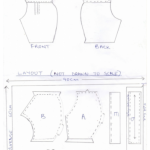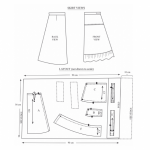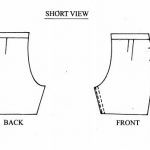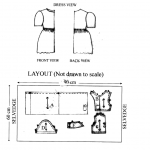KNEC KCSE Past Papers 2018 Home Science Paper 2 (441/2)
BOY’S SHORT
A pattern of a boy’s short is provided. You are advised to study the sketches, instructions and layout carefully before you begin the test.
MATERIALS PROVIDED
1. Pattern Pieces
A. Short back
B. Short front
C. Pocket
D. Waistband
2. Plain lightweight cotton fabric 55 cm long by 90 cm wide.
3. Seeing thread to match the fabric.
4. One large envelope.
The Test
Using the materials provided, cut out and make the LEFT SIDE of the boy’s short to show the following processes:
(a) Cutting out. (9½ marks)
(b) Making of the back dart.(5½ marks)
(c) Making of the inner leg seam using a French seam.(7½ marks)
(d) Attaching the in-seam pocket. (12 marks)
(e) Working of the side seam using an open seam and neatening the sectlon below the pocket. (12 marks)
(f) Preparing and attaching the interfaced waistband. (Do not trim the seam).
(i) Tack the back part waistband using even tacking.
(ii) Top stitch the edge of waistband. (22 marks)
(g) Managing the hem. Machine stitch half of the hem. (Do not remove tacking stitches).(15 marks)
(h) Overall presentation. (6½ marks)
At the end of the examination, firmly sew onto your work, on a single fabric, a label bearing your name and index number. Remove the needles, pins and loose threads from your work. Fold your work neatly and place it in the envelope provided. Do not put scraps of fabric in the envelope. Do not seal the envelope.

Questions and Answers
Home Science Paper 2 (441/2)
1. Presentation
(a)Work well pressed (1) and folded (½).
(b) Label (½) firmly fixed (1) without concealing details (½) and on a single fabric (½).
(c) Pins/needles (½) tacking threads (½) and unnecessary threads (½) removed.
(d) Made up for the left half(1).
Sub-total 6 ½
2. Cutting Out
(a) (b) All five pattern pieces cut-out (5 x ½).
Smooth cutting of short CF (1) and on straight (c) grain (½)
Smooth cutting of short CB (1) and on straight grain (½)
(d) Waistband CB. smoothly cut (½) and on straight
(e) grain (½ )
Waistband CF. smoothly cut (½ ) and on straight grain (½)
Pocket smoothly cut (2 x ½) and straight grain (2 x½)
3. Dart
(a) Straight stitchery (1) tapering to a point (½) (b) Thread ends well fastened at the point.
(c) Correct depth of dart 6.8cm to with 3mm (6.5— 7.fern)
(d) Correct width of dart 0.8cm to within 3mm (0.5- 1.1cm)
(e) Dart pressed towards C.B.
Flatness of dart of R.S. (½) and W.S. (½) (no pockets formed)
Sub-total 5½
4. Pocket
(a) Front pocket attached to front short (1) with
straight stitchery (1) with R.S together(1)
§) Back pocket attached to back short (1) with
straight stitchery (1) with R.S together(1) 3 (c) Pocket bag facing down (1) and correct shape(1)
(d) Pocket mouth reinforced at the top (½) and bottom(½)
(e) Smooth stitchery of curved edges of pocket (lx2).
Pocket mouth left open 1
Sub-total 12
5. Open Seam
(a)Joined with straight stitchery (1×2) Evenness of seam (½ x 2)
(b) Raw edges well neatened below the pocket (1x 2)
(c) Seam pressed open (½ x 2) and flat (½ x 2) on (d) W.S. (½ x 2) and R.S. ( 2 x 2).
(e) Width of seam 1.0cm to within 2mm (0.8cm — 1.2cm) (1×2)
(f) Seam snipped above and below the pocket (½ x 2)
Sub-total 12
6. French Seam (inner leg seam)
If not French Seam give zero (0)
(a) Seam well-trimmed(1) no threads on the R.S(1)
(b) Straight stitchery.
(c) Seam well knife edged.
(d) Evenness of seam.
(e) Correct size (6mm) to within 2mm (4mm-8mm)
(ft Seam pressed towards the back at the hem
(g) Flatness of seam at hem R.S. (½) and W S. (½)
(h) Hem folded and matching at the inner leg seam to within 2mm. 1
Sub-total 8½
7. Waist Band
(a) Waistband joined with straight stitchery.
(b) Waistband well knife edged (1 x 2)
(c) Waistband correctly attached with straight stitch- ery (1 x 2) and not trimmed (½ x 2) (d) Waistband even (1 x 2) and notches matching
(e) Raw edges of back waistband well tucked under. 1 Flatness of waistband on R.S. (1) and W.S. (1).
(g) Correct width of waistband 3.7cm to within 3mm (3.4cm— 4.0cm) (1 x 2).
(h) Waistband edges flash with CF (½) and C.B. (½).
Waistband interfaced. 1
(i) Waistband evenly top stitched. 2
(j) Quality of even tacking (if not even tacking (k) award zero)
Sub-total 22
8. Hem Management
Raw edges well turned (2) and held down with tacking stitches (1) using a single thread (1) Machine stitches straight (l) and close to the edge (1).
Flatness of hem on R.S. (1 x 2) and W.S. (1 x 2). Evenness of hem (1 x 2)
Correct width of hem 2.8cm to within 2mm (2.6 3.0cm) (1 x 2)






